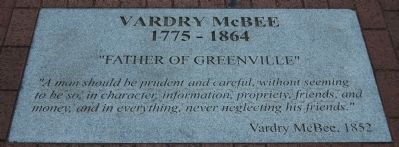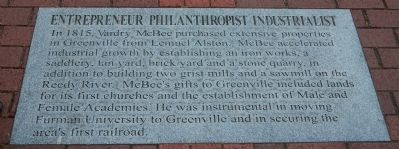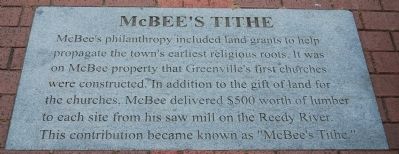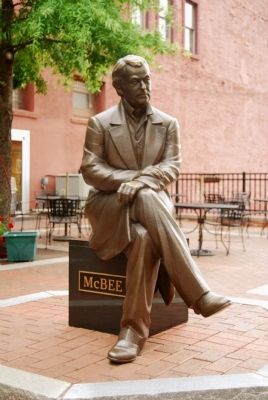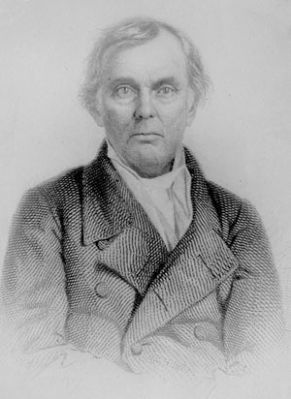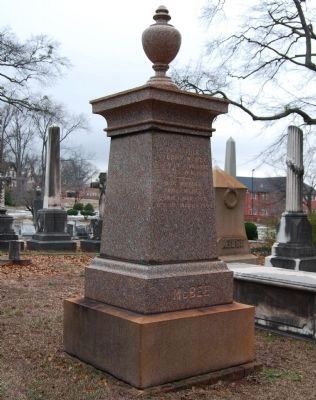Greenville in Greenville County, South Carolina — The American South (South Atlantic)
Vardry McBee
(1775–1864)
— “Father of Greenville” —
“A man should be prudent and careful, without seeming to be so, in character, information, propriety, friends, and money, and in everything, never neglecting his friends.” Vardry McBee, 1852.
Erected 2002 by Greenville County Historical Society.
Topics. This historical marker is listed in these topic lists: Churches & Religion • Industry & Commerce • Settlements & Settlers. A significant historical year for this entry is 1852.
Location. 34° 50.923′ N, 82° 23.982′ W. Marker is in Greenville, South Carolina, in Greenville County. Marker is at the intersection of South Main Street and East Court Street, on the left when traveling south on South Main Street. The monument is located directly in front of the Old Record Building monument and across from the entrance to the Westin Poinsett Hotel in downtown Greenville, SC. Touch for map. Marker is in this post office area: Greenville SC 29601, United States of America. Touch for directions.
Other nearby markers. At least 8 other markers are within walking distance of this marker. The Old Record Building (here, next to this marker); Poinsett's Spring (a few steps from this marker); Joel Roberts Poinsett (within shouting distance of this marker); a different marker also named Joel Roberts Poinsett (within shouting distance of this marker); Chamber of Commerce Building (within shouting distance of this marker); South Carolina's First National Bank (within shouting distance of this marker); a different marker also named South Carolina's First National Bank (about 300 feet away, measured in a direct line); Spirit of Freedom (about 300 feet away). Touch for a list and map of all markers in Greenville.
More about this marker. This statue and memorial is one of several located in downtown Greenville, honoring some of the famous people who called Greenville home.
Also see . . . Lemuel J. Alston. Lemuel James Alston (1760–1836) was a U.S. Representative from South Carolina. (Submitted on December 6, 2011, by Brian Scott of Anderson, South Carolina.)
Additional commentary.
1. Vardry McBee
Vardry McBee was perhaps the most pivotal figure in the history of our city and Greenville County as a whole. thanks to his business acumen and impressive foresight for how the community could grow and prosper.
A product of the Carolina frontier, McBee was born in 1775 on the eve of the American Revolution, a conflict that would prove formative in his early years. Both his father and older brother fought with the Patriots, at King's Mountain and the Battle of Cowpens. McBee himself never fought for American independence, but instead used his considerable fortune to improve the lives of his fellow citizens, appropriating his land and fortunes to public projects.
McBee opened the first textile mill on the Reedy River, but he saw value in a diversified economy. In his private business life, that meant he owned two flour mills, a cotton factory, and wool and paper mills. Publicly, even as he approached his 80s, it led him to champion the construction of a railroad line that connected Columbia and Greenville. In 1853, this line became the first rail to serve the community, and it would eventually become a turning point in the economy of the town. (Source: G: The Magazine of Greenville, Jan/Feb 09, pg 66.)
— Submitted December 6, 2011, by Brian Scott of Anderson, South Carolina.
2. McBee's Tithe
Vardry McBee, the father of Greenville, donated land and $500 worth of limber from his mill on the Reedy River to five congregations. This act was known as McBee's Tithe. These were the first five churches in downtown Greenville (and they contribute to Greenville's nickname: the Church City). The five churches are: First Baptist, First Presbyterian, Christ Church (Episcopal), St. Mary's Catholic, and Buncombe Street United Methodist.
— Submitted December 6, 2011, by Brian Scott of Anderson, South Carolina.
3. Lemuel James Alston (1760 - 1836)
Lemuel James Alston, a Representative from South Carolina; born in the eastern part of Granville (now Warren) County, N.C., in 1760; moved to South Carolina after the Revolutionary War and settled near Greens Mill, which soon became the town of Greenville; studied law; was admitted to the bar and commenced practice in Greenville; member of the State house of representatives, 1789-1790; elected as a Republican to the Tenth and Eleventh Congresses (March 4, 1807-March 3, 1811); moved in 1816 to Clarke County, Ala., and settled near Grove Hill, where he presided over the orphans’ court and the county court from November 1816 until May 1821; died at “Alston Place,” Clarke County, Ala., in 1836. (Source: Biographical Directory of the U.S. Congress.)
— Submitted December 6, 2011, by Brian Scott of Anderson, South Carolina.
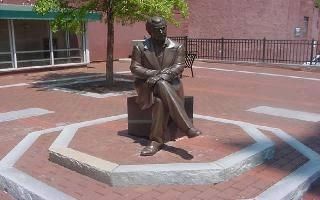
Photographed By Stanley and Terrie Howard
5. Vardry McBee
Vardry McBee statue - The Sculptor for this project was T.J. Dixon of San Diego. The location is at Court Square on E. Court Street. He constructed 100 buildings in Greenville County and built a textile mill along the Reedy River. He gave land to five downtown churches, all of which gave $5,000 toward cost of the statue.
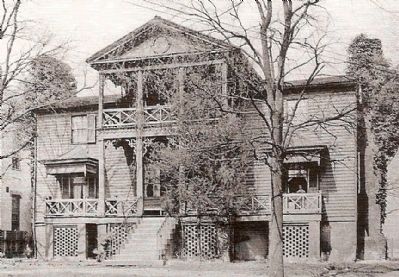
Photographed By Brian Scott, circa 1900
8. Prospect Hill
Home of Vardry McBee
Home of Vardry McBee
Prospect Hill was originally the home of Lemuel Alston, one of Greenville's earliest settlers. In 1815, Alston moved to Clarke County, Alabama, where he died in 1835. In 1836, McBee moved to Greenville from Lincolnton, North Carolina, and made Prospect Hill his home. He lived in the house until his death in 1864. The home was demolished in 1920.
Credits. This page was last revised on December 13, 2019. It was originally submitted on June 2, 2008, by Brian Scott of Anderson, South Carolina. This page has been viewed 4,757 times since then and 51 times this year. Last updated on October 30, 2018, by Bruce Guthrie of Silver Spring, Maryland. Photos: 1, 2, 3, 4. submitted on June 2, 2008, by Brian Scott of Anderson, South Carolina. 5. submitted on September 8, 2008, by Stanley and Terrie Howard of Greer, South Carolina. 6. submitted on December 6, 2011, by Brian Scott of Anderson, South Carolina. 7. submitted on January 11, 2009, by Brian Scott of Anderson, South Carolina. 8. submitted on April 13, 2009, by Brian Scott of Anderson, South Carolina. • Andrew Ruppenstein was the editor who published this page.
